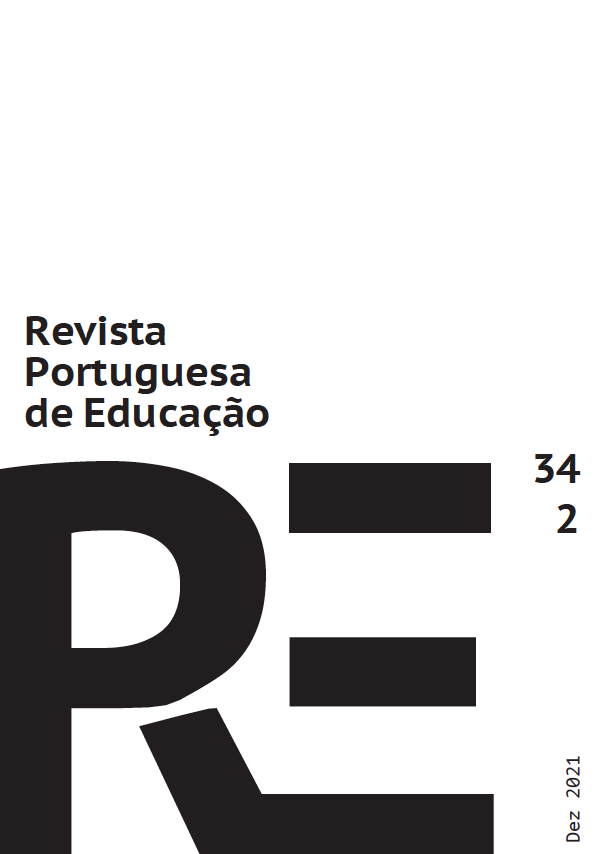School performance and different roles of participation in bullying: A cross-cultural study
DOI:
https://doi.org/10.21814/rpe.17330Keywords:
School Violence, Bullying, School PerformanceAbstract
The relationship between bullying and school performance is a complex phenomenon and intimidation can contribute to poor school performance. The aim of this study was to compare school performance between the roles of involvement in bullying, segregated by country - Portugal and Brazil. They participated in 785 children and adolescents. The participation in bullying roles, there was the couple indicated by Partner Scale Metric. Already the school performance was evaluated by the final averages at the end of the school year four disciplines. It is noteworthy that in Portugal the victims showed better school performance. In Brazil no significant differences were found. The data show that school performance seems to be a more important variable in establishing the bullying participation roles in Portugal than in Brazil, indicating that the relationship between these variables cannot be considered a standard feature among those involved in this phenomenon in different countries.
Downloads
References
Al-Bitar, Z. B., Al-Omari, I. K., Sonbol, H. N., Al-Ahmad, H. T. & Cunningham, S. J. (2013). Bullying among Jordanian schoolchildren, its effects on school performance, and the contribution of general physical and dentofacial features. Am J Orthod Dentofacial Orthop, 144(6), 872-878. http://doi.org/10.1016/j.ajodo.2013.08.016
Albdour, M. & Krouse, H. J. (2014). Bullying and victimization among African American adolescents: a literature review. J Child Adolesc Psychiatr Nurs, 27(2), 68-82. http://doi.org/10.1111/jcap.12066
Anthony, B. J., Wessler, S. L. & Sebian, J. K. (2010). Commentary: guiding a public health approach to bullying. J Pediatr Psychol, 35(10), 1113-1115. http://doi.org/10.1093/jpepsy/jsq083
Barboza, G. E. (2015). The association between school exclusion, delinquency and subtypes of cyber- and F2F-victimizations: identifying and predicting risk profiles and subtypes using latent class analysis. Child Abuse Negl, 39, 109-122. http://doi.org/10.1016/j.chiabu.2014.08.007
Barboza, G. E., Schiamberg, L. B., Oehmke, J., Korzeniewski, S. J., Post, L. A. & Heraux, C. G. (2009). Individual characteristics and the multiple contexts of adolescent bullying: an ecological perspective. J Youth Adolesc, 38(1), 101-121. http://doi.org/10.1007/s10964-008-9271-1
Bilić, V., Flander, G. B. & Rafajac, B. (2014). Life satisfaction and school performance of children exposed to classic and cyber peer bullying. Coll Antropol, 38(1), 21-29.
Bowes, L., Maughan, B., Ball, H., Shakoor, S., Ouellet-Morin, I., Caspi, A., . . . Arseneault, L. (2013). Chronic bullying victimization across school transitions: the role of genetic and environmental influences. Dev Psychopathol, 25(2), 333-346. http://doi.org/10.1017/S0954579412001095
Busch, V., Laninga-Wijnen, L., Schrijvers, A. J. & De Leeuw, J. R. (2015). Associations of health behaviors, school performance and psychosocial problems in adolescents in The Netherlands. Health Promot Int., 32(2), 280-291. http://doi.org/10.1093/heapro/dav058
Cardoos, S. L. & Hinshaw, S. P. (2011). Friendship as protection from peer victimization for girls with and without ADHD. J Abnorm Child Psychol, 39(7), 1035-1045. http://doi.org/10.1007/s10802-011-9517-3
Chang, F. C., Lee, C. M., Chiu, C. H., Hsi, W. Y., Huang, T. F., & Pan, Y. C. (2013). Relationships among cyberbullying, school bullying, and mental health in Taiwanese adolescents. J Sch Health, 83(6), 454-462. http://doi.org/10.1111/josh.12050
Coie, J. D., Dodge, K. A. & Coppotelli, H. (1982). Dimensions and types of social status: A cross-age perspective. Developmental Psychology, 18, 557–570.
Copeland, W. E., Wolke, D., Angold, A. & Costello, E. J. (2013). Adult psychiatric outcomes of bullying and being bullied by peers in childhood and adolescence. JAMA Psychiatry, 70(4), 419-426. http://doi.org/10.1001/jamapsychiatry.2013.504
Cornell, D. & Mehta, S. B. (2011). Counselor confirmation of middle school student self-reports of bullying victimization. Professional School Counseling, 14(4), 261–270.
Costa, P. & Pereira, B. (2010). O bullying na escola: a prevalência e o sucesso escolar. Paper presented at the I Seminário Internacional “Contributos da Psicologia em Contextos Educativos”, Braga.
Craig, W., Harel-Fisch, Y., Fogel-Grinvald, H., Dostaler, S., Hetland, J., Simons-Morton, B., Molcho, M., Mato, M. G., Overpeck, M., Due, P. & Pickett, W. (2009). A cross-national profile of bullying and victimization among adolescents in 40 countries. International Journal of Public Health, 54(2), 216-224.
Dalosto, M. M. & Alencar, E. M. L. S. (2013). Manifestações e prevalência de bullyng entre alunos com altas habilidades/superdotação. Revista Brasileira de Educação Especial, 19, 363-378.
Elias, L. (2003). Crianças que apresentam baixo rendimento escolar e problemas de comportamento associados: caracterização e intervenção [Doctoral dissertation, Universidade de São Paulo, Brasil]. https://repositorio.usp.br/item/001334977
Espelage, D. L. & de la Rue, L. (2013). School bullying: its nature and ecology. In J. C. Srabstein & J. Merrick (Eds.), Bullying: A Public Health Concern (pp. 23-38). Nova Science Publishers
Freire, I., Simão, A. & Ferreira, A. (2006). O estudo da violência entre pares no 3º ciclo do ensino básico: um questionário aferido para a população escolar portuguesa. Revista Portuguesa de Educação, 19(2), 157-183.
Galvão, D. P. (2009). Os nerds ganham poder e invadem a TV. Revista Intraciência, 001, 34-41.
Glew, G. M., Fan, M. Y., Katon, W. & Rivara, F. P. (2008). Bullying and school safety. J Pediatr, 152(1), 123-128, 128.e121. http://doi.org/10.1016/j.jpeds.2007.05.045
Gower, A. L., McMorris, B. J., & Eisenberg, M. E. (2015). School-level contextual predictors of bullying and harassment experiences among adolescents. Soc Sci Med, 147, 47-53. http://doi.org/10.1016/j.socscimed.2015.10.036
Harel-Fisch, Y., Walsh, S. D., Fogel-Grinvald, H., Amitai, G., Pickett, W., Molcho, M., . . . Group, M. o. t. H. V. a. I. P. F. (2011). Negative school perceptions and involvement in school bullying: a universal relationship across 40 countries. J Adolesc, 34(4), 639-652. http://doi.org/10.1016/j.adolescence.2010.09.008
Huepe, D., Roca, M., Salas, N., Canales-Johnson, A., Rivera-Rei, Á., Zamorano, L., . . . Ibañez, A. (2011). Fluid intelligence and psychosocial outcome: from logical problem solving to social adaptation. PLoS One, 6(9), e24858. http://doi.org/10.1371/journal.pone.0024858
Khamis, V. (2015). Bullying among school-age children in the greater Beirut area: risk and protective factors. Child Abuse Negl, 39, 137-146. http://doi.org/10.1016/j.chiabu.2014.08.005
Krukowski, R. A., West, D. S., Philyaw Perez, A., Bursac, Z., Phillips, M. M. & Raczynski, J. M. (2009). Overweight children, weight-based teasing and academic performance. Int J Pediatr Obes, 4(4), 274-280. http://doi.org/10.3109/17477160902846203
Kubwalo, H., Muula, A. S., Siziya, S., Pasupulati, S. & Rudatsikira, E. (2013). Prevalence and correlates of being bullied among in-school adolescents in Malawi: results from the 2009 Global School-Based Health Survey. Malawi Med J, 25(1), 12-14.
Lam, S. F., Law, W., Chan, C. K., Wong, B. P. & Zhang, X. (2015). A latent class growth analysis of school bullying and its social context: the self-determination theory perspective. Sch Psychol Q, 30(1), 75-90. http://doi.org/10.1037/spq0000067
Levandoski, G. & Cardoso, F. (2013). Imagem corporal e status social de estudantes brasileiros envolvidos em bullying. Revista Latinoamericana de Psicología, 45(1), 135-145.
Lopes Neto, A. (2005). Bullying: comportamento agressivo entre estudantes. J Pediatr (Rio J), 81(5), 164- 172.
Martini, M. & Boruchovitch, E. (1999). As atribuições de causalidade, o desenvolvimento infantil e o contexto escolar. PSICO-USF, 4(2), 23-36.
Nakamoto, J. & Schwartz, D. (2010). Is peer victimization associated with academic achievement? A meta-analytic review. Social Development, 19, 221–242. http://doi.org/10.1111/j.1467-9507.2009.00539.x
Nansel, T. R., Overpeck, M., Pilla, R. S., Ruan, W. J., Simons-Morton, B. & Scheidt, P. (2001). Bullying behaviors among US youth: prevalence and association with psychosocial adjustment. JAMA, 285(16), 2094-2100. http://doi.org/joc01746 [pii]
Olweus, D. (1994). Bullying at school: basic facts and effects of a school based intervention program. J Child Psychol Psychiatry, 35(7), 1171-1190.
Ortega, R., Elipe, P., Mora-Merchán, J. A., Genta, M. L., Brighi, A., Guarini, A., . . . Tippett, N. (2012). The emotional impact of bullying and cyberbullying on victims: a European cross-national study. Aggress Behav, 38(5), 342-356. http://doi.org/10.1002/ab.21440
Pereira, B., Mendonça, D., Neto, C., Velente, L. & Smith, P. (2004). Bullying in portuguese schools. School Psychology International, 25(2), 207-222.
Pinheiro, F., Stelko-Pereira, A. & Williams, L. d. A. (2010). Bullying escolar: caracterização dos alunos envolvidos, responsabilidade dos educadores e possibilidades de redução do problema. In G. d. E. d. Paraná & S. d. E. d. Educação (Eds.), Enfrentamento à violência na escola (pp. 77-88). SEED.
Puhl, R. M. & King, K. M. (2013). Weight discrimination and bullying. Best Pract Res Clin Endocrinol Metab, 27(2), 117-127. http://doi.org/10.1016/j.beem.2012.12.002
Rettew, D. C. & Pawlowski, S. (2016). Bullying. Child Adolesc Psychiatr Clin N Am, 25(2), 235-242. http://doi.org/10.1016/j.chc.2015.12.002
Santos, L. & Marturano, E. (1999). Crianças com dificuldades de aprendizagem: um estudo de seguimento. Psicologia: Reflexão e Crítica, 12, 377-393
Shirley, E. L. & Cornell, D. (2012). The contribution of student perceptions of school climate to understanding the disproportionate punishment of African American students in a middle school. School Psychology International, 33(2), 115–134. http://doi.org/10.1177/0143034311406815
Silva, M. & Pereira, B. (2008). A violência como fator de vulnerabilidade na ótica de adolescentes escolares. In J. Bonito (Coord.), Educação para a Saúde no Século XXI: Teorias, Modelos e Práticas. Universidade de Évora
Smith, P. (2004). Bullying: Recent Developments. Child and Adolescent Mental Health, 9(3), 98–103.
Smith-Khuri, E., Iachan, R., Scheidt, P. C., Overpeck, M. D., Gabhainn, S. N., Pickett, W. & Harel, Y. (2004). A cross-national study of violence-related behaviors in adolescents. Arch Pediatr Adolesc Med, 158(6), 539-544. http://doi.org/10.1001/archpedi.158.6.539
Smokowski, P. R. & Kopasz, K. H. (2005). Bullying in school: An overview of types, effects, family characteristics, and intervention strategies. Children & Schools, 27(2), 101–110. http://doi.org/10.1093/cs/27.2.101
Stevanato, I., Loureiro, S., Linhares, M. & Marturano, E. (2003). Autoconceito de crianças com dificuldades de aprendizagem e problemas de comportamento. Psicologia em Estudo, 8(1), 67-76.
Wang, W., Vaillancourt, T., Brittain, H. L., McDougall, P., Krygsman, A., Smith, D., . . . Hymel, S. (2014). School climate, peer victimization, and academic achievement: results from a multi-informant study. Sch Psychol Q, 29(3), 360-377. http://doi.org/10.1037/spq0000084
Wolke, D., Woods, S., Stanford, K. & Schulz, H. (2001). Bullying and victimization of primary school children in England and Germany: prevalence and school factors. Br J Psychol, 92(Pt 4), 673-696.
Yang, S. J., Stewart, R., Kim, J. M., Kim, S. W., Shin, I. S., Dewey, M. E., . . . Yoon, J. S. (2013). Differences in predictors of traditional and cyber-bullying: a 2-year longitudinal study in Korean school children. Eur Child Adolesc Psychiatry, 22(5), 309-318. http://doi.org/10.1007/s00787-012-0374-6
Zequinão, M. A., Cardoso, A. A., da Silva, J. L., de Medeiros, P., Silva, M. A. L., Pereira, B. & Cardoso, F. L. (2017). Academic performance and bullying in socially vulnerable students. Journal of Human Growth and Development, 27(1), 19-27. https://doi.org/10.7322/jhgd.127645
Downloads
Published
How to Cite
Issue
Section
License
Copyright (c) 2021 Portuguese Journal of Education

This work is licensed under a Creative Commons Attribution-ShareAlike 4.0 International License.
1. The authors preserve their authorship and grant the Portuguese Journal of Education the right to the first publication. The work is licensed under Creative Commons Attribution License that allows sharing the work with the acknowledgment of initial authorship and publication in this Journal.
2. The authors have the right to take additional contracts separately, for non-exclusive distribution of the published version of their work (e.g. to deposit in an institutional repository or as a book chapter), acknowledging the initial authorship and publication in this Journal.
3. The authors have the permission and are stimulated to post their work online (e.g. in an institutional repository or on their personal website). They can do this at any phase of the editorial process, as it may generate productive changes, as well as increase impact and article citation (see The Open Citation Project).
The work is licensed under Attribution-ShareAlike 4.0 International (CC BY-SA 4.0)




















